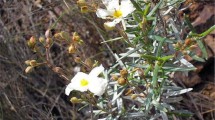Abstract
Essential oil of the subterranean part of Cacalia tangutica (Maxim.) Hand.-Mazz was analyzed by gas chromatography (GC)-mass spectrum (MS) technique in two different capillary columns of different polarities. Thirty-one components were identified in the oil and the main compounds were α-zingiberene (13.49%), germacrene D (10.76%), α-pinene (8.54%), caryophyllene(Z-) (6.36%), linalool (6.16%), β-myrcene (4.89%), β-ocimene (Z-) (4.40%)and ocimenone(Z-) (3.58%). The antimicrobial activity of the oil was evaluated against 2 fungi and 12 bacteria including 6 clinically isolated strains using the agar disc diffusion and broth microdilution methods. The results show that the oil presented a broad antimicrobial spectrum and had better antimicrobial activity against yeast and gram-positive bacteria. The minimum inhibitory concentration values were 0.16–5.00 g/L and minimum bactericidal concentration values were 0.16–5.00 g/L.
Similar content being viewed by others

References
Adams R P (2001). Identification of Essential Oils Components by Gas Chromatagraphy/Quadrupole Mass Spectroscopy. Carol Stream, Illinois, USA: Allured Publishing Corporation
Carson C F, Riley T V (1995). Antimicrobial activity of the major components of the essential oil Melaleuca alternifolia. Journal of Applied Bacteriology, 78: 264
Chen J W, Li X, Wu L L, Wu L L, Shi R H (2000). Study on constituents of volatile oil of the tender stem and leaf of rare and precious Chinese medicinal plant Changium smyrnioides Wolff. Natural Product Research and Development, 12(3): 48–51(in Chinese)
Cosentino S, Tuberoso C I, Pisano B, Satta M, Mascia V, Arzedi E, Palmas F (1999). In-vitro antimicrobial activity and chemical composition of Sardinian Thymus essential oils. Letters in Applied Microbiology, 29(2): 130
Hou K Z (1998). A Dictionary of the Families and Genera of Chinese Seed Plants, 2nd ed. Beijing: Science Press: 75 (in Chinese)
Juteau F, Masotti V, Bessière J M, Dherbomez M, Viano J (2002). Antibacterial and antioxidant activities of Artemisia annua essential oil. Fitoterapia, 73(6): 532–535
Liao F X, Xin L T, Chen H, Xia Z N (2004). Analysis of the constituents of volatile oil from Fructus Aurantii Immaturus and Fructus Aurantii as traditional Chinese medicine. Journal of Chongqing University, 27(5): 38–40 (in Chinese)
Liu Z L, Tian X (2004). The components of Cacalia tangutica. Bulletin of the Korean Chemical Society, 25(7): 1078–1080
Marino M, Bersani C, Comi G (2001). Impedance measurements to study the antimicrobial activity of essential oils from Lamiaceace and Compositae. International Journal of Food Microbiology, 67: 187–195
Northwest Plateau Institute of Biology, the Chinese Academy of Sciences (1987). Economic Flora of Qinghai, 2nd ed. Xining: Qinghai People’s Publishing House: 602–603
Sibanda S, Chigwada G, Poole M, Gwebu E T, Noletto JA, Schmidt JM, Rea A I, Setzer W N (2004). Composition and bioactivity of the leaf essential oil of Heteropyxis dehniae from Zimbabwe. Journal of Ethnopharmacology, 92: 107–111
Tan L F, Zhong C L, Chen Y J, Yang L S, Yin L (2003). Antimicrobial activity of curry powder essential oil and their analysis by GC/MS. China Condiment, 11: 6–10 (in Chinese)
Wang P F, Yang C, Jia Z J (2003). Studies on the chemical constituents of Cacalia pilgeriana. Journal of Lanzhou University (Natural Sciences), 39(2): 61–63 (in Chinese)
Wang W J (2005). Recent Advances on Limonene,a Natural and Active Monoterpene. China Food Additives, 1: 33–37(in Chinese)
Wei Y, Zhang X, Wei L, Yang X S (2005). Analysis of the constituents of volatile oil from Pimpinella candolleana Wight et Arn. Journal of Guiyang Traditional Chinese Medical University, 27(4): 56–57 (in Chinese)
Xia Z D, Yu J L (2000). Study on the effect of the biosynthesis of Candida albicans by α-Pinene. China Journal of Modern Medicine, 10(1): 44–46 (in Chinese)
Yu J Q, Lei J C, Yu H D, Cai X Q, Zou G L (2004). Chemical composition and antimicrobial activity of the essential oil of Scutellaria barbata. Photochemistry, 65: 881–884
Yue M E, Jiang T F, Liu X, Shi Y P (2005). Separation and determination of coumarins from Cacalia tangutica by capillary zone electrophoresis. Biomedical Chromatography, 19: 250–254
Zhang J, Wu G P, Zeng J Y, Yao J (2005). Studies on the essential constituent from Cacalia tangutica(Maxim.) Hand.-Mazz’s Flower. Chinese Journal of the Practical Chinese with Modern Medicine, 18(4): 600–602 (in Chinese)
Zhang S M, Zhao G L, Li R, Lin G Q (1998). Eremophilane Sesquiterpenes from Cacalia Roborowskii. Phytochemistry, 48: 519–524
Zhou L J, Huang J G, Xu H H, Wu R H (2006). Insecticidal Activities of Two Active Components from a Chinese Indigenous Plant, Sinacalia tangutica(Maxim.) B Nord against Musca domestica vicina Macquart Adults. Acta Entomologica Sinica, 49(1): 74–79 (in Chinese)
Zhu S Y, Yang Y, Yu H D, Ying Y, Zou G L (2005). Chemical composition and antimicrobial activity of the essential oils of Chrysanthemum indicum. Journal of Ethnopharmacology, 96: 151–158
Author information
Authors and Affiliations
Corresponding author
Additional information
__________
Translated from Journal of Wuhan University (Science Edition), 2007, 53 (2): 198–203 [译自: 武汉大学学报(理学版)]
Rights and permissions
About this article
Cite this article
Yang, Y., Zhu, S., Cai, X. et al. Chemical composition and antimicrobial activity of the essential oil of Cacalia tangutica (Maxim.) Hand.-Mazz. Front. Biol. China 3, 402–407 (2008). https://doi.org/10.1007/s11515-008-0073-3
Published:
Issue Date:
DOI: https://doi.org/10.1007/s11515-008-0073-3


